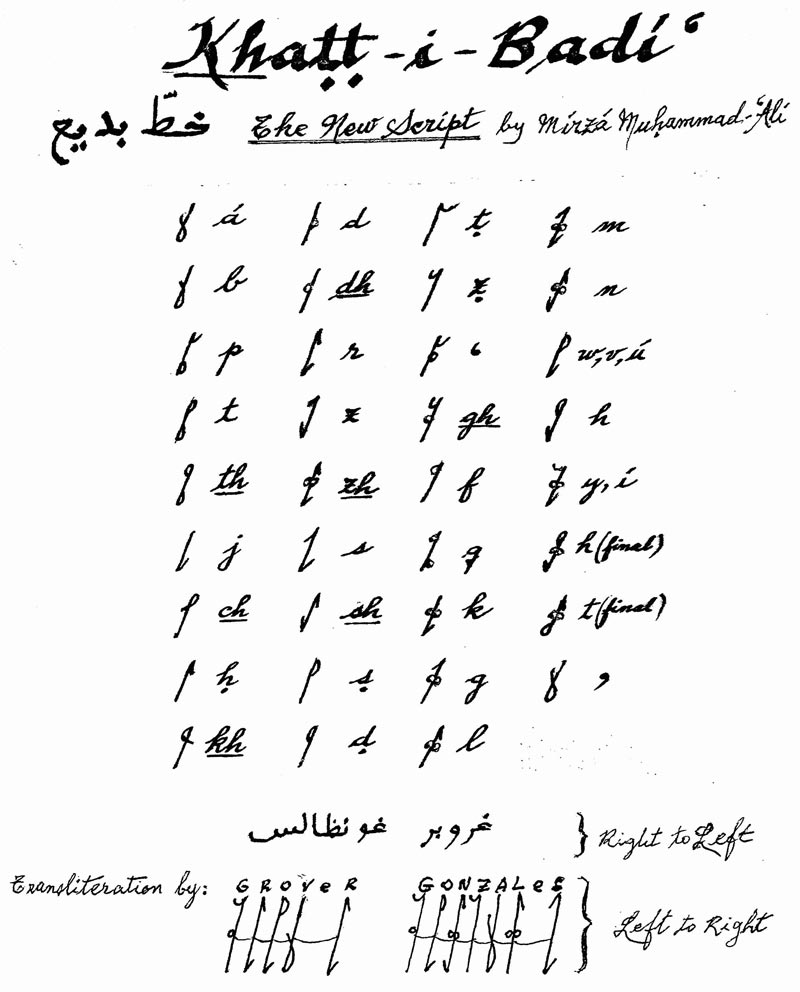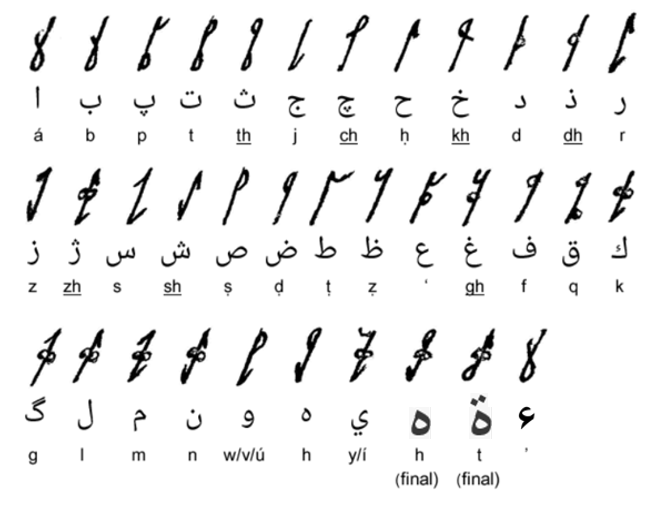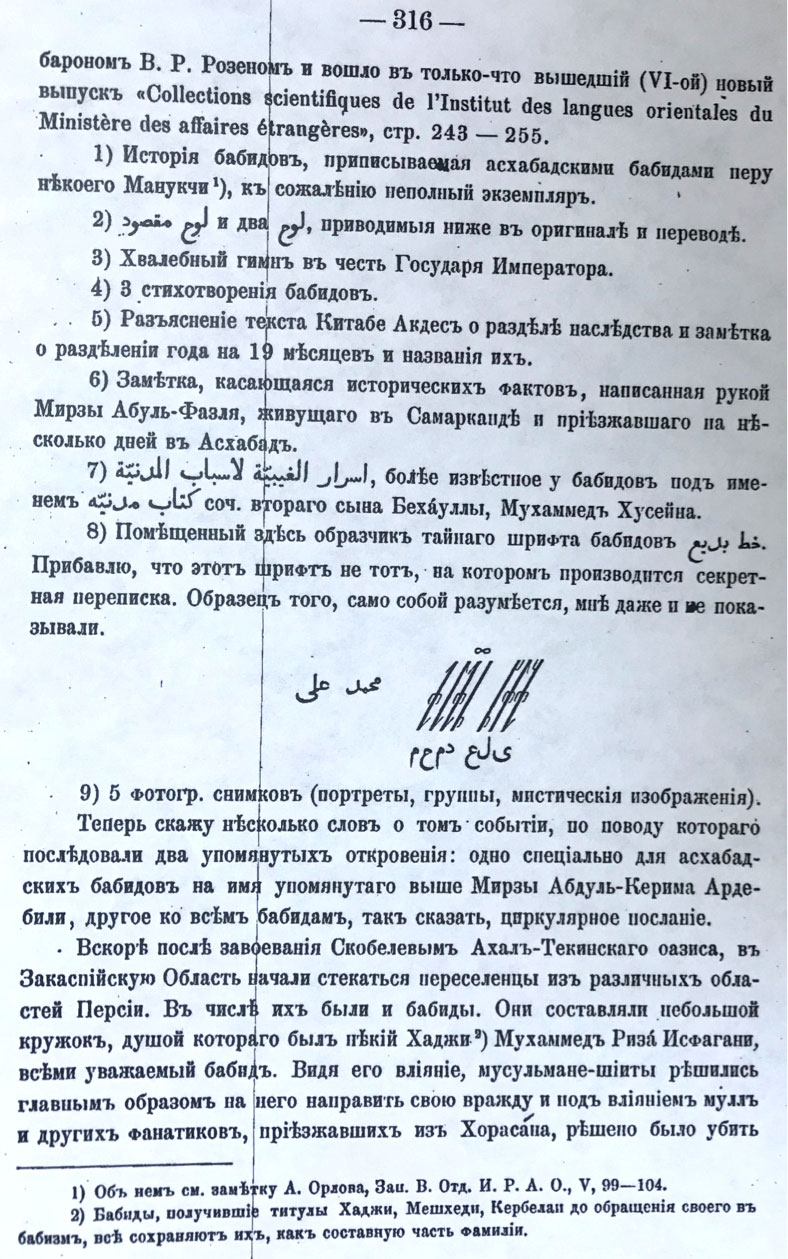
|
|
Abstract:
Latin transliteration of Mírzá Muhammad-'Alí's "conlang" alphabet by Grover Gonzales. Includes notes by the Universal House of Justice, an overview by Gonzales, and samples of the script.
|
1. Introductory letter from the Universal House of Justice, 1997 August 6
|
|
Mr. ... asks a number of questions about the new language (and script) 'Khatt-i-Badí', mentioned in 'Christopher Buck's book on the 'Kitáb-i-Iqán', and in the 'Epistle to the Son of the Wolf'. He wishes to know who created this language, why it was never used and whether any printed example of it exists. Khatt-i-Badí' was a new script devised by Mírzá Muhammad 'Alí, half-brother of 'Abdu'l-Bahá and a calligrapher of great renown. We have attached for Mr. ...'s study a sample of this new script [see image at right] which appears on the last page of a collection of Bahá'u'lláh's Tablets published in 1891 (1308 A.H.). Mírzá Muhammad 'Alí calligraphed these Tablets and signed his name at the bottom of the last page using the alphabet of the new script. The Research Department has been unable to find any description of how this alphabet functions. Mr. ... also asks whether the Khatt-i-Badí' is connected in some way with the following statement of Bahá'u'lláh found in the Epistle to the Son of the Wolf:
We have been unable to find any direct reference in the Bahá'í Writings to a connection between Bahá'u'lláh's statement above and the Khatt-i-Badí' ; however, we do know that Bahá'u'lláh did not commission Mírzá Muhammad 'Alí to devise this alphabet, nor did He subsequently approve it. Furthermore, we have the following statements taken from letters in Persian written on behalf of the Guardian concerning Bahá'u'lláh's statement in the Epistle to the Son of the Wolf:
|
 Khatt-i-Badi script |


In the West, the first to give notice of this writing was the well-known Orientalist E. G. Browne who writes that “...at Shíráz I first saw specimens of the New Writing of the Bábís...I did not learned to read or write it...The writing is intended for a time when Babism shall become the state religion of some country. It is called by the Bábís Khatt-i-Badí' and there are several varieties of it.” It included a short description of the script. (JRAS, 21:3, p.498, July 1889)
The 'several varieties', most probably refers to the Persian Bayán VII : 1, “The grades of writing are the degrees of the name Wahíd (i.e. 19). First ' Khatt-i-Abhá ', and last ' Khatt-i-'Alá' '; and it seemeth as though in the Manifestation, the learned will attain to write all 19 hand writings; but perfection in one is better than knowing all, though perfection in all is the highest perfection.” And in idem IX : 2 ,“And this whatever writing he writes from Abhá to 'Alá', which are the degrees of the Wahíd. And of the five kinds of writings of the Nuqtá whatever he writes is acceptable. In this Manifestation no writing is more acceptable than the Shikasta.”
It is evident that the Báb is referring to styles like the Shikastih, rather than to a new alphabet. The name itself is not found in the degrees of the first Wahíd and, in this case the Khatt-i-Badí' refers to a 'Unique' Alphabet.
The House of Justice letter of 6/8/1997 includes this important statement: “...we do know that Bahá'u'lláh did not commission Mírzá Muhammad 'Alí to devise this alphabet, nor did He subsequently approve it.” And also: “The Research Department has been unable to find any description of how this alphabet functions.”
The Khatt-i-Badí' alphabet represents each letter of the Arabic with the additional Persian letters. Contrary to Arabic and Persian, it is written from left to right. To form a word, the letters are bound with a connective garland. All letters consist of a large vertical line slanted to the right and, to particularize each letter it appends diacritical marks at its upper and lower ends, like thin half arrows and hangers, and half ogives (“whirl”), to the right or left or both sides according to the letter; besides, it also has little circles (“eye”) used in the same way and also at the center, which altogether gives more than 1,500 combinations. The writing has neither elegance nor easiness and is rather cumbersome and difficult to memorize due to the very minor differences among the letters. It was mostly used by Muhammad-'Alí and his friends, like Mullá 'Ahmad 'Alí Nayrízí, the calligrapher of the Book of Haykal and Hájí Mírzá Husayn Shirází (Khartumí) or as he called himself “Husayn who was exiled to Khartoum”, the calligrapher of the Kitáb-i-Aqdás and also of The Book of Supplications (Bombay 1891/1308 HD) Later it was used mostly as a secret code.
The Khatt-i-Badí' must not be identified as the new language referred to by Bahá'u'lláh in The Epistle to the Son of the Wolf (p. 138-9) that reads: “At present, a new language and a new script have been devised. If thou desirest, We will communicate them to thee.” Shoghi Effendi indicates in a Persian letter that “He [Bahá'u'lláh] left them undisclosed and undivulged. A new language and a new script were hidden in the treasury of His knowledge. No seeker was found; therefore, they were not disclosed.” (12 January 1929; provisional translation)
The transliteration to the Latin alphabet was done using the guides of the Tenth International Congress (Geneva 1894) that was extensively used by Shoghi Effendi. Since he did not transliterate his own name, it seems that it could be modified, He did not use the vowels e and o that could improve the pronunciation, e.g. Qoddus instead of Quddús or Mehdi for Mihdí.
Interest regarding this writing in the West was mostly shown by the English Browne and the Russian Toumanski. The former in his Catalogue and Description of 27 Bábí Manuscripts, p. 709, n. 3 (JRAS 1892) refers to Muhammad-Alí' and says: “He it was, I believed, who invented the different forms of the Khatt-i-Badi', or 'New Writing.' Of this writing I was unable to obtain a specimen, but I learned from Baron Rosen that M. Toumansky was more fortunate, and that amongst the treasures he brought back from 'Istikabad (sic) were the words Muhammad-'Alí written in the new characters.” More recently a new interest arose, so that a letter from the Research Department was issued: "We have attached for Mr. ...'s study a sample of this new script which appears on the last page of a collection of Bahá'u'lláh's Tablets published in 1891 (1308 A.H.). Mírzá Muhammad 'Alí calligraphed these Tablets and signed his name at the bottom of the last page using the alphabet of the new script. The Research Department has been unable to find any description of how this alphabet functions.”
This letter complicates deciphering the script. Muhammad-'Alí had copied fourteen collections of Tablets of his Father but, the one that was printed in 1891/1308 AH in Bombay, he assigned to Hájí Mírzá Husayn Shirází (Khartumí) Besides, the signature at the bottom of the last page (although blurry) is not that of Muhammad-'Ali' but of “Husayn who was (exiled, silent ?) in al-Khartoum.” The New Script is gone, as well as, the memory of its author, who passed to the mercy of God with grief and without glory. However, there will also be this human curiosity that, thanks God, is unavoidable.
Addendum: E. G. Browne writes that Toumanski received from Ashkhabad some Bahá’í writings in which the Khatt-i-Badí’ is shown. The Russian scholar Youli Ioannesyan has sent some material on the subject that, although he considers poor on this issue, actually has in it the correct name of Muhammad-Alí’ written in the New Script (Dva Posledenkh Babid Skikh Otkroveniya, 1892, p. 316). This corroborates the finding that, the Tablet of Bahá’u’lláh presented in the Notes was not inscribed by Muhammad-Ali’ but, by Hájí Mírzá Husayn Shírazí (Khartumí). — G.G.
 Dva Posledenkh Babid Skikh Otkroveniya p. 316 |
| METADATA | |
| Views | 7475 views since posted 2018-07-08; last edit 2018-07-08 UTC; previous at archive.org.../gonzales_transliteration_khatt_badi |
| Permission | editor |
| Share | Shortlink: bahai-library.com/4782 Citation: ris/4782 |
|
|
|
|
Home
search: Author Links |
|